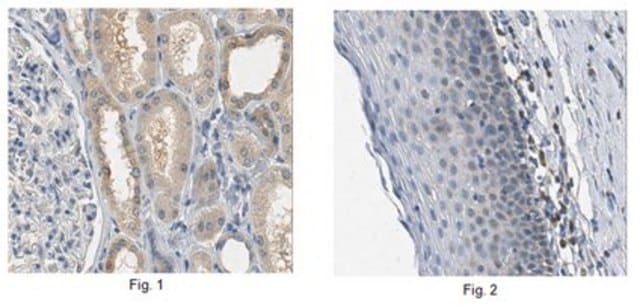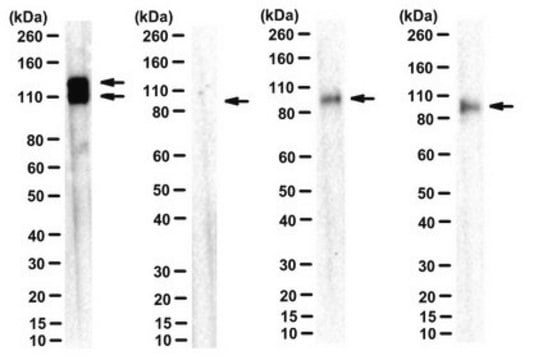一般說明
We are committed to bringing you greener alternative products, which adhere to one or more of The 12 Principles of Green Chemistry.This antibody is Preservative-free, produced without the harm or sacrifice of animals and exceptionally stable to allow for ambient shipping and storage if needed and thus aligns with "Waste Prevention", "Designing Safer Chemicals" and "Design for Energy Efficiency".
Click here for more information.
ZooMAb
® antibodies represent an entirely new generation of recombinant monoclonal antibodies.
Each ZooMAb
® antibody is manufactured using our proprietary recombinant expression system, purified to homogeneity, and precisely dispensed to produce robust and highly reproducible lot-to-lot consistency. Only top-performing clones are released for use by researchers. Each antibody is validated for high specificity and affinity across multiple applications, including its most commonly used application. ZooMAb
® antibodies are reliably available and ready to ship when you need them.
Learn more about ZooMAb here.特異性
Clone 1I9 is a ZooMAb® rabbit recombinant monoclonal antibody that specifically detects Guanine nucleotide exchange C9orf72. It targets an epitope within 15 amino acids from the C-terminal half.
免疫原
KLH-conjugated linear peptide corresponding to 15 amino acids from the C-terminal half of human C9orf72.
應用
Quality Control Testing
Evaluated by Western Blotting in HeLa cell lysate.
Western Blotting Analysis: A 1:10,000 dilution of this antibody detected C9ORF72 (long form) in HeLa cell lysate.
Tested applications
Western Blotting Analysis: A 1:10,000 dilution from a representative lot detected C9ORF72 (long form) in LNCaP and SH-SY5Y cell lysates.
Immunohistochemistry (Paraffin) Analysis: A 1:1,000 dilution from a representative lot detected C9ORF72 (long form) in mouse brain tissue sections.
Immunocytochemistry Analysis: A 1:100 dilution from a representative lot detected C9ORF72 (long form) in SH-SY5Y cells.
Affinity Binding Assay: A representative lot of this antibody bound C9ORF72 peptide with a KD of 1.0 x 10-12 in an affinity binding assay.
Note: Actual optimal working dilutions must be determined by end user as specimens, and experimental conditions may vary with the end user
Anti-C9ORF72 (long form), clone 1I9 ZooMAb®, Cat. No. ZRB1307, is a recombinant Rabbit monoclonal antibody that targets C9ORF72 (long form) and is tested for use in Affinity Binding Assay, Immunocytochemistry, Immunohistochemistry, and Western Blotting.
標靶描述
Guanine nucleotide exchange C9orf72 (UniProt: Q96LT7; also known as C9orf72) is encoded by the C9orf72 gene (Gene ID: 203228) in human. C9orf72 is a low abundant, cytoplasmic, highly soluble protein. The long isoform (481 amino acids) is shown to be the predominant form that is expressed in human brain. Expansion of a GGGGCC (G4C2) hexanucleotide repeat sequence in the non-coding region of human C9orf72 is the most common genetic abnormality in familial and sporadic frontotemporal dementia (FTD) and motor neuron disease (MND), with amyotrophic lateral sclerosis (ALS) as the most frequent form. The majority of normal human C9orf72 alleles carry less than 20 repeats, whereas large expansions consisting of hundreds or thousands of repeats lead to disease. C9orf72 generates three transcripts through alternative splicing that encode 2 protein isoforms; a long isoform of about 54 kDa (termed C9-L), corresponding to variants 2 and 3, and a short isoform of about 24 kDa (termed C9-S) corresponding to variant 1. Both isoforms are widely expressed, including kidney, lung, liver, heart, testis and several brain regions, including cerebellum, and frontal cortex. Both, C9-L and C9-S are reported to display distinct subcellular localizations in cerebellar Purkinje cells of both c9-ALS and nonc9-ALS cases. C9-L is shown to be spread diffusely throughout the cytoplasm, whereas C9- S is localized to the nuclear membrane of Purkinje cells of both c9-ALS and non-c9-ALS cases. Also, C9-L is shown to be present mainly in the high-salt Triton and urea-soluble fractions, whereas C9-S is shown to be abundant in both the low- and high-salt Triton fractions, indicating differences in their subcellular localizations. This ZooMAb® recombinant monoclonal antibody, generated by our propriety technology, offers significantly enhanced specificity, affinity, reproducibility, and stability over conventional monoclonals. (Ref.: Frick, P., et al. (2018). Acta Neuropathol. Commun. 6(1); 72).
外觀
Purified recombinant rabbit monoclonal antibody IgG, lyophilized in PBS with 5% Trehalose, normal appearance a coarse or translucent resin. The PBS/trehalose components in the ZooMAb formulation can have the appearance of a semi-solid (bead like gel) after lyophilization. This is a normal phenomenon. Please follow the recommended reconstitution procedure in the data sheet to dissolve the semi-solid, bead-like, gel-appearing material. The resulting antibody solution is completely stable and functional as proven by full functional testing. Contains no biocide or preservatives, such as azide, or any animal by-products. Larger pack sizes provided as multiples of 25 μL.
重構
300 μg/mL after reconstitution at 25 μL per vial. Please refer to guidance on suggested starting dilutions and/or titers per application and sample type.
儲存和穩定性
Recommend storage of lyophilized product at 2-8°C; Before reconstitution, micro-centrifuge vials briefly to spin down material to bottom of the vial; Reconstitute each vial by adding 25 μL of filtered lab grade water or PBS; Reconstituted antibodies can be stored at 2-8°C, or -20°C for long term storage. Avoid repeated freeze-thaws.
法律資訊
ZooMAb is a registered trademark of Merck KGaA, Darmstadt, Germany
免責聲明
Unless otherwise stated in our catalog or other company documentation accompanying the product(s), our products are intended for research use only and are not to be used for any other purpose, which includes but is not limited to, unauthorized commercial uses, in vitro diagnostic uses, ex vivo or in vivo therapeutic uses or any type of consumption or application to humans or animals.










